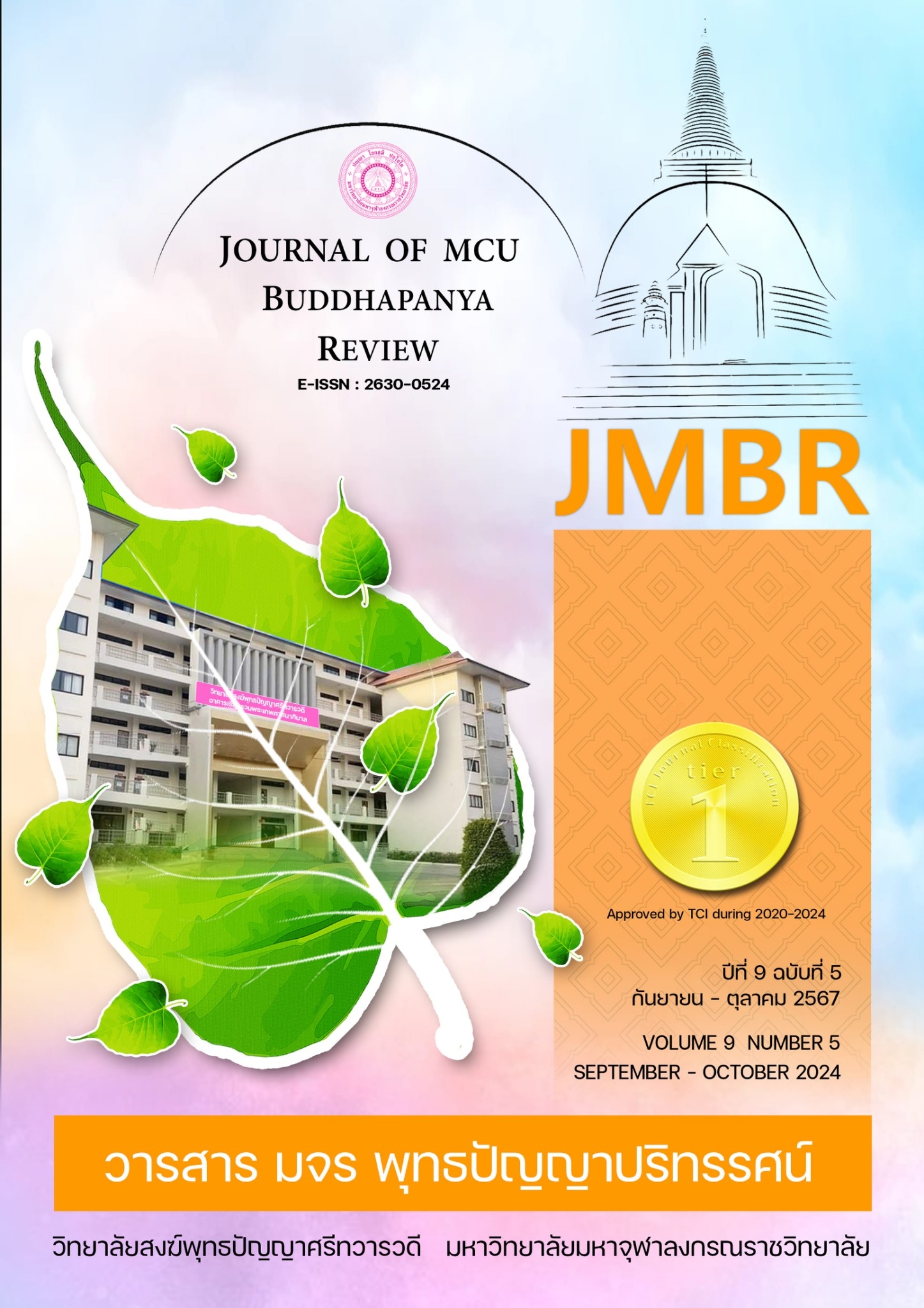THE DEVELOPMENT OF OPEN INNOVATION STRATEGY MODEL ON TECHNOLOGY FIRM PERFORMANCE IN SHENZHEN, CHINA
คำสำคัญ:
Open Innovation, Technological Effect, Innovation Collaborative Partnershipsบทคัดย่อ
This study investigates the impact of open innovation strategies on the performance of technology firms in Shenzhen, a leading innovation hub in China. Given the rapid evolution of the global business landscape, technology firms are compelled to adopt innovative strategies to remain competitive. Open innovation, characterized by the integration of external knowledge and collaborative ventures, is increasingly recognized as essential for sustaining competitive advantage. Utilizing a mixed-methods approach, this research delineates how open innovation influences various performance metrics, including product innovation, market reach, and financial outcomes. Quantitative analysis alongside qualitative insights from industry leaders provides a robust framework for understanding the efficacy of open innovation practices. The findings underscore the significant role of strategic external collaborations in enhancing firm performance and navigating the complexities of the high-tech industry. This study contributes to the existing literature by offering a detailed examination of the mechanisms through which open innovation can drive corporate success in technologically intensive environments.
เอกสารอ้างอิง
Alexy, O., George, G., & Salter, A. J. (2013). Cui bono? The selective revealing of knowledge and its implications for innovative activity. Academy of Management Review, 38(2), 270-291.
Bogers, M., & Lhuillery, S. (2011). A functional perspective on learning and innovation: Investigating the organization of absorptive capacity. Industry and Innovation, 18(6), 581-610.
Berchicci, L. (2013). Towards an open R&D system: Internal R&D investment, external knowledge acquisition and innovative performance. Research Policy, 42(1), 117-127.
Bogers, M., Zobel, A. K., Afuah, A., Almirall, E., Brunswicker, S., Dahlander, L., ... & Hossain, M. (2017). The open innovation research landscape: Established perspectives and emerging themes across different levels of analysis. Industry and Innovation, 24(1), 8-40.
Brunswicker, S., & Vanhaverbeke, W. (2015). Open innovation in small and medium-sized enterprises (SMEs): External knowledge sourcing strategies and internal organizational facilitators. Journal of Small Business Management, 53(4), 1241-1263.
Chen, J. H., & Chen, I. H. (2019). The impact of resource allocation on new product development performance: Evidence from Taiwanese high-tech firms. Journal of Business Research, 104, 383-391.
Chesbrough, H. (2003). Open Innovation: The New Imperative for Creating and Profiting from Technology. Harvard Business School Press.
Chesbrough, H. (2006). Open Business Models: How to Thrive in the New Innovation Landscape. Harvard Business School Press.
Christensen, J. F., Olesen, M. H., & Kjær, J. S. (2005). The industrial dynamics of Open Innovation—Evidence from the transformation of consumer electronics. Research Policy, 34(10), 1533-1549.
Cummings, J. N., & Kiesler, S. (2007). Coordination costs and project outcomes in multi-university collaborations. Research Policy, 36(10), 1620-1634.
Chesbrough, H., & Bogers, M. (2014). Explicating open innovation: Clarifying an emerging paradigm for understanding innovation. In New Frontiers in Open Innovation, 3-28. Oxford University Press.
Chiaroni, D., Chiesa, V., & Frattini, F. (2010). Unravelling the process from closed to open innovation: evidence from mature, asset‐intensive industries. R&D Management, 40(3), 222-245.
Cohen, W. M., Nelson, R. R., & Walsh, J. P. (2002). Links and impacts: The influence of public research on industrial R&D. Management Science, 48(1), 1-23.
Dahlander, L., & Gann, D. M. (2010). How open is innovation?. Research Policy, 39(6), 699-709.
Denicolai, S., Ramirez, M., & Tidd, J. (2020). The role of absorptive capacity in open innovation and Technology firm performance. Journal of Business Research, 113, 15-28.
Pisano, G. P., & Verganti, R. (2008). Which kind of collaboration is right for you?. Harvard Business Review, 86(12), 78-86.
Rajesh, R., & Ramachandran, K. (2021). Investigating the construct validity of open innovation practices in Indian manufacturing firms. Journal of Open Innovation: Technology, Market, and Complexity, 7(2), 49.
Randhawa, K., Wilden, R., & Hohberger, J. (2016). A bibliometric review of open innovation: Setting a research agenda. Journal of Product Innovation Management, 33(6), 750-772.
Rosenbusch, N., Brinckmann, J., & Bausch, A. (2019). Is innovation always beneficial? A meta-analysis of the relationship between innovation and performance in SMEs. Journal of Business Venturing, 34(3), 431-450.
Salter, A. J., & Alexy, O. (2014). The nature of innovation. Oxford Review of Economic Policy, 30(1), 97-108.
Roper, S., Du, J., & Love, J. H. (2008). Modelling the innovation value chain. Research Policy, 37(6-7), 961-977.
Schroll, A., & Mild, A. (2012). Open innovation modes and the role of internal R&D: An empirical study on open innovation adoption in Europe. European Journal of Innovation Management, 15(4), 500-523.
Teece, D. J. (2007). Explicating dynamic capabilities: The nature and microfoundations of (sustainable) enterprise performance. Strategic Management Journal, 28(13), 1319-1350.
Trochim, W. M., & Donnelly, J. P. (2008). The research methods knowledge base (3rd ed.). Atomic Dog Publishing.
Tsekouras, D., Nikolaou, A. I., & Papazoglou, M. (2021). Open innovation practices and innovation performance: The moderating role of innovation orientation. Journal of Business Research, 133, 726-735.
Un, C. A., & Asakawa, K. (2015). Types of R&D collaborations and process innovation: The benefit of collaborating upstream in the knowledge chain. Journal of Product Innovation Management, 32(1), 138-153.
Van de Vrande, V., de Jong, J. P., Vanhaverbeke, W., & de Rochemont, M. (2009). Open innovation in SMEs: Trends, motives and management challenges. Technovation, 29(6-7), 423-437.
Vega-Jurado, J., Gutiérrez-Gracia, A., & Fernández-de-Lucio, I. (2009). Does external knowledge sourcing matter for innovation? Evidence from the Spanish manufacturing industry. Industrial and Corporate Change, 18(4), 637-670.
Wallin, M. W., & von Krogh, G. (2010). Organizing for open innovation: Focus on the integration of knowledge. Organizational Dynamics, 39(2), 145-154.
West, J., & Gallagher, S. (2006). Challenges of open innovation: The paradox of firm investment in open-source software. R&D Management, 36(3), 319-331.
Wulf, T., & Butelmann, P. (2017). Open innovation and firm performance: The mediating role of social capital. Creativity and Innovation Management, 26(2), 97-114
Witzeman, S., Slowinski, G., Dirkx, R., Gollob, L., Tao, J., Ward, S., & Miraglia, L. (2006). Harnessing external technology for innovation. Research-Technology Management, 49(3), 27-35.
Yu, H., Li, X., & Jiang, K. (2021). How does open innovation affect operational performance? The mediating role of absorptive capacity and the moderating role of intellectual property rights protection. Journal of Business Research, 128, 187-199.
Zeng, S. X., Xie, X. M., & Tam, C. M. (2010). Relationship between cooperation networks and innovation performance of SMEs. Technovation, 30(3), 181-194.
ดาวน์โหลด
เผยแพร่แล้ว
รูปแบบการอ้างอิง
ฉบับ
ประเภทบทความ
สัญญาอนุญาต
ลิขสิทธิ์ (c) 2025 วารสาร มจร พุทธปัญญาปริทรรศน์

อนุญาตภายใต้เงื่อนไข Creative Commons Attribution-NonCommercial-NoDerivatives 4.0 International License.



